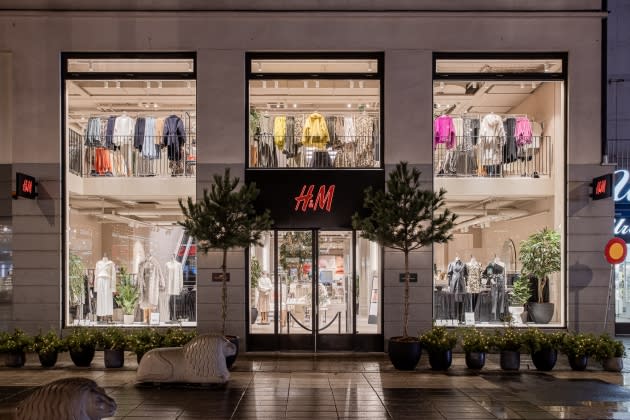Supply Chain Pressures, Ukraine War Weigh on H&M

PARIS — The ongoing impact of the pandemic, supply chain pressures and increased investments dinted H&M Group’s profitability in the first quarter. The impact of the war in Ukraine, meanwhile, is weighing on current trading, the Swedish fast-fashion retailer said Thursday.
The news sent H&M’s share down in early trading. At 11:30 a.m. CET, its shares were down 9.7 percent on Wednesday’s closing price, at 130.76 Swedish kronor, or $13.93.
More from WWD
In March, H&M, which operates Cos, Monki, & Other Stories, Arket and Weekday as well as its core banner, said sales in local currencies increased 6 percent. Not including the impact of Russia, Belarus and Ukraine, local-currency sales for the period gained 11 percent, the company reported.
H&M closed its stores in Ukraine in late February to protect employees and shuttered its operations in Russia and Belarus — a total of 171 outlets — at the beginning of March, as reported.
The group’s sixth-largest market last year, Russia accounted for around 4 percent of H&M Group’s sales in the year to Nov. 30. It opened 13 new stores there last year.
“Russia was one of the most important growth markets and it was also very profitable,” said H&M Group’s head of investor relations Nils Vinge on a call with analysts.
For the three months to Feb. 28, H&M Group reported operating profit of 458 million Swedish kronor, or $48.8 million at current exchange. This compared with an operating loss of 1.13 billion Swedish kronor, or $123.6 million, in the same period a year ago.
The company’s net profit for the period came in at 217 million Swedish kronor, or $23.1 million, compared with a net loss of 1.07 billion Swedish kronor, or $114 million, last year.
This was below market expectations, and H&M said the impact of cost pressures — notably increased freight prices — had hit earlier than anticipated and that its investment in growth-related initiatives, particularly within tech and the supply chain, had also weighed on profitability.
“Having ended last year with sales back at the same level as before the pandemic and in a strong financial position, we started the new year with increased initiatives to create an even better foundation for long-term growth,” stated H&M Group chief executive officer Helena Helmersson.
Looking ahead, H&M will be increasing its prices — in some markets, it has already begun to do so — to factor in higher costs. “We won’t give our customer all of the burden, we have to take part of it,” Vinge said. “But, of course, given the substantial input price increases, we need to adjust.”
“We see that customers appreciate our collection and we believe that we are well positioned with our complete offer to be successful within this inflationary trend,” added chief financial officer Adam Karlsson.
Given the market challenges, the company is also reassessing its investments. “In the current environment, we have to be agile and make holistic assessments; margins and profitability are also important for us,” said Vinge, without giving further specifics.
When in January it revealed full-year results for 2021 alongside ambitious new 2030 sales and sustainability targets, H&M said it would double its investments this year, planning capital expenditures of around 10 billion Swedish kronor, or $1.07 billion.
The retailer said its business in the first quarter had continued to be impacted by the negative effects of the pandemic in many of its major markets. “In addition to the general consequences of the pandemic such as disruptions and delays in the supply chain, some of our major markets were impacted by a new wave of the pandemic in the first quarter,” Helmersson said.
First-quarter sales in local currencies increased 18 percent year-over-year, and in reported terms, they were up 23 percent to 49.17 billion Swedish kronor, or $5.24 billion, as reported. In physical stores, revenues gained 38 percent year-over-year, while online sales were just below those of a year ago, the company said.
At present, more than 40 stores in China are closed due to pandemic-related restrictions. Meanwhile, the company is seeing strong development in both North and South America, the U.K. and India, Helmersson said during the call.
H&M Group is aiming to double revenues by 2030 while halving its carbon footprint, as reported. Increasing the share of full-priced products and less reliance on markdowns are a key focus for the retailer currently, and during the first quarter, it beat its own expectations for those goals, the company said.
SEE ALSO:
H&M Plans to Double Sales, Halve Carbon Footprint by 2030
H&M Group Sales Gain 23% in Q1
H&M, Nike and Puma Alter Operations in Russia in Response to Invasion of Ukraine
Sign up for WWD's Newsletter. For the latest news, follow us on Twitter, Facebook, and Instagram.
